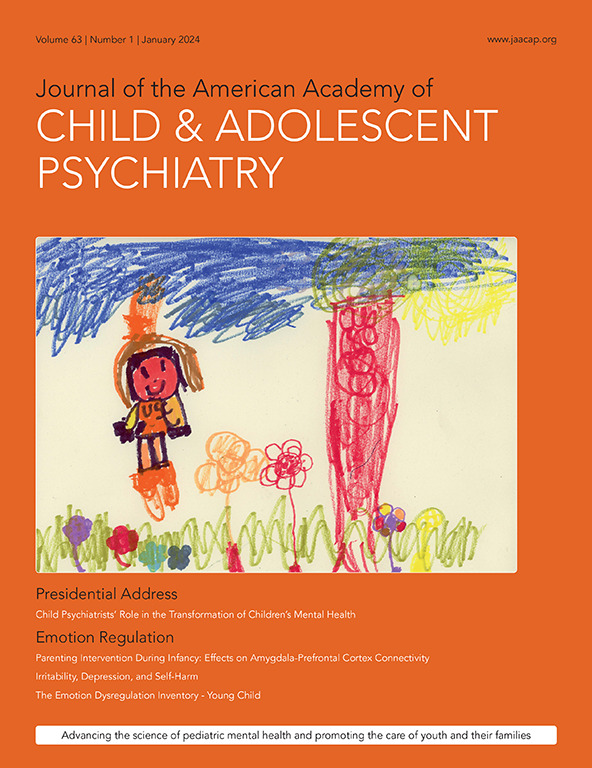儿童的心理健康症状会影响他们在家中获得未上锁的枪支吗?
IF 9.5
1区 医学
Q1 PEDIATRICS
Journal of the American Academy of Child and Adolescent Psychiatry
Pub Date : 2025-04-23
DOI:10.1016/j.jaac.2025.04.011
引用次数: 0
摘要
目的探讨儿童心理健康症状的变化是否预示着他们在家中获得未上锁枪支的变化。方法:本研究使用了来自美国东南部1420名青少年及其父母的纵向队列研究数据。父母每年对9至16岁的孩子的心理健康(即行为,对立违抗,抑郁和焦虑症状)进行多达8次的评估(总共6,674次观察)。家长们还被问及家中是否有枪,是否上锁。使用广义线性混合效应模型来检验症状变化与经社会人口变量调整的家庭枪支获取之间的关联。在分析中,有或没有获得未锁定枪支的儿童在基线时进行了区分。结果66%的父母报告说,他们的孩子在9-16岁之间的某个时候接触过一把未上锁的枪。在儿童在基线时没有获得枪支的家庭中,青少年心理健康症状的变化并没有增加或减少儿童随后获得未上锁枪支的可能性。然而,在基线时儿童确实有枪支接触的家庭中,一些心理健康症状(对立违抗性(OR= 0.43, CI=[0.35, 0.53], p<0.001)或抑郁症状(OR=0.74, CI=[0.59, 0.92], p<0.008)的增加与下一个时间点的枪支接触减少有关。这些关联在青少年中最为明显。结论:在一个枪支文化强烈的地区,当孩子表现出情绪或行为症状时,父母报告说他们会对孩子的枪支接触做出安全意识的调整。本文章由计算机程序翻译,如有差异,请以英文原文为准。
Do Children's Mental Health Symptoms Impact Their Access to Unlocked Guns at Home?
OBJECTIVE
To test whether changes in children's mental health symptoms predict changes in their access to unlocked guns at home.
METHOD
This study used data from a longitudinal cohort study of 1,420 youth and their parents in the Southeastern US. Parents were assessed annually up to eight times about their child's mental health (i.e., conduct, oppositional defiant, depression, and anxiety symptoms) between ages 9 to 16 (6,674 observations total). Parents were also asked whether there were guns in their home and whether they were locked. Generalized linear mixed-effect models were used to test associations between changes in symptoms and in-home gun access adjusted for sociodemographic variables. Children with or without access to unlocked guns at baseline were differentiated in analyses.
RESULTS
Sixty-six percent of parents reported that their child had access to an unlocked gun at some point between ages 9-16. In homes in which children did not have gun access at baseline, changes in youth mental health symptoms did not increase or decrease the likelihood of child having access to unlocked guns subsequently. In homes in which children did have guns access at baseline, however, increases in some mental health symptoms (either oppositional defiant (OR= 0.43, CI=[0.35, 0.53], p<0.001), or depression symptom (OR=0.74, CI=[0.59, 0.92], p<0.008)) were associated with reduced gun access at the next timepoint. These associations were strongest for adolescents.
CONCLUSION
In an area where gun culture is strong, parents reported making safety-conscious adjustments to their children's gun access when their children displayed emotional or behavioral symptoms.
求助全文
通过发布文献求助,成功后即可免费获取论文全文。
去求助
来源期刊
CiteScore
21.00
自引率
1.50%
发文量
1383
审稿时长
53 days
期刊介绍:
The Journal of the American Academy of Child & Adolescent Psychiatry (JAACAP) is dedicated to advancing the field of child and adolescent psychiatry through the publication of original research and papers of theoretical, scientific, and clinical significance. Our primary focus is on the mental health of children, adolescents, and families.
We welcome unpublished manuscripts that explore various perspectives, ranging from genetic, epidemiological, neurobiological, and psychopathological research, to cognitive, behavioral, psychodynamic, and other psychotherapeutic investigations. We also encourage submissions that delve into parent-child, interpersonal, and family research, as well as clinical and empirical studies conducted in inpatient, outpatient, consultation-liaison, and school-based settings.
In addition to publishing research, we aim to promote the well-being of children and families by featuring scholarly papers on topics such as health policy, legislation, advocacy, culture, society, and service provision in relation to mental health.
At JAACAP, we strive to foster collaboration and dialogue among researchers, clinicians, and policy-makers in order to enhance our understanding and approach to child and adolescent mental health.

 求助内容:
求助内容: 应助结果提醒方式:
应助结果提醒方式:


